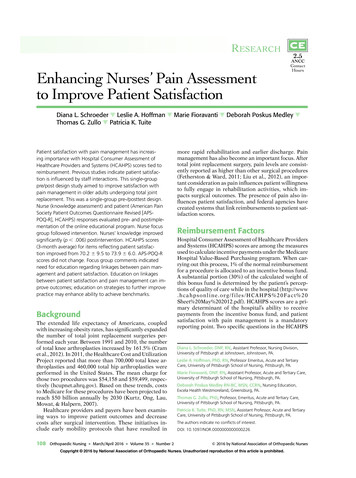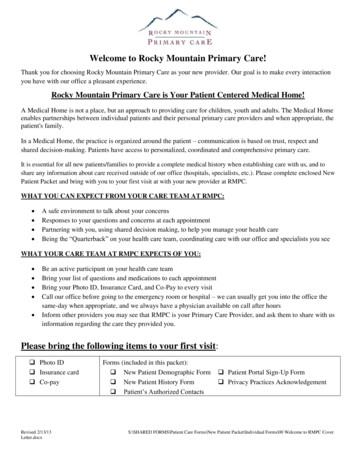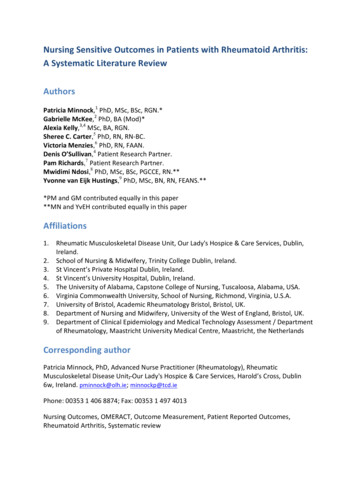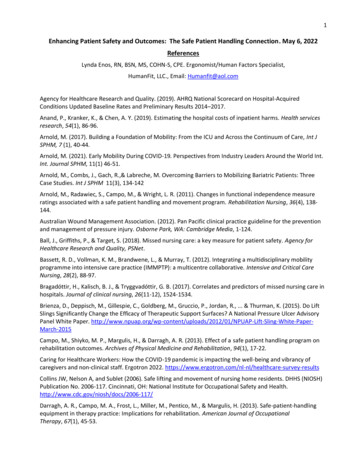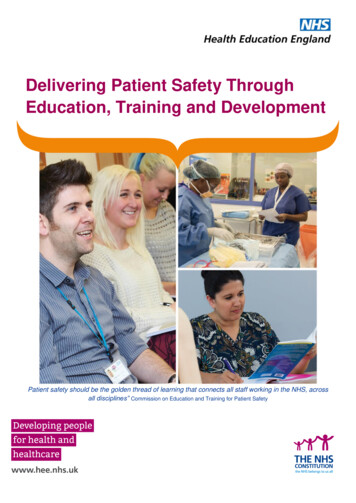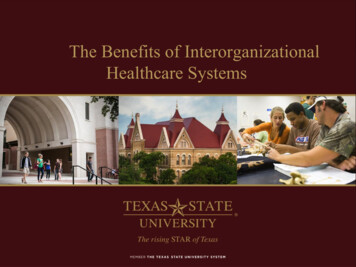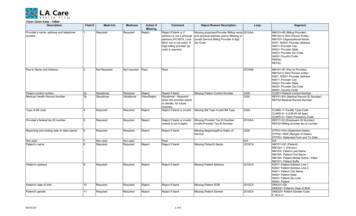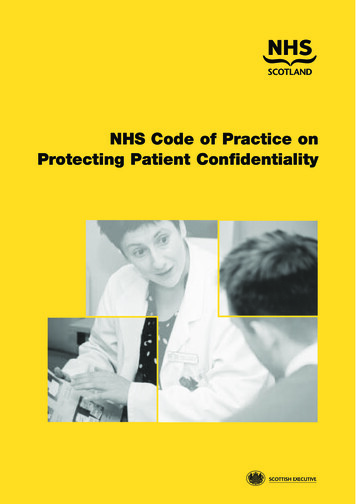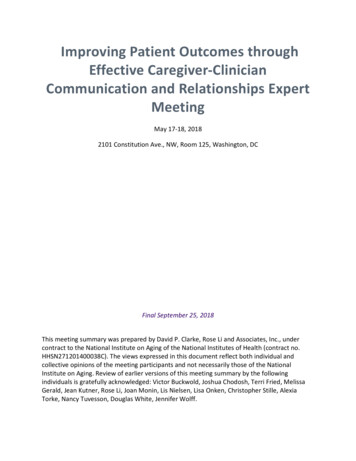
Transcription
Improving Patient Outcomes throughEffective Caregiver-ClinicianCommunication and Relationships ExpertMeetingMay 17-18, 20182101 Constitution Ave., NW, Room 125, Washington, DCFinal September 25, 2018This meeting summary was prepared by David P. Clarke, Rose Li and Associates, Inc., undercontract to the National Institute on Aging of the National Institutes of Health (contract no.HHSN271201400038C). The views expressed in this document reflect both individual andcollective opinions of the meeting participants and not necessarily those of the NationalInstitute on Aging. Review of earlier versions of this meeting summary by the followingindividuals is gratefully acknowledged: Victor Buckwold, Joshua Chodosh, Terri Fried, MelissaGerald, Jean Kutner, Rose Li, Joan Monin, Lis Nielsen, Lisa Onken, Christopher Stille, AlexiaTorke, Nancy Tuvesson, Douglas White, Jennifer Wolff.
Improving Patient Outcomes through Effective Caregiver-Clinician Communication and Relationships,May 17-18, 2018Table of ContentsMeeting Summary . 1Introduction .1A Model of Caregiver/Third-Party Involvement in Clinical Interactions .1The Role and Involvement of Caregivers in Patient-Clinician Relationships .2Understanding the Quality of Shared Decision-Making. 2Strategies to Improve Surrogate Decision Making for Incapacitated, Seriously Ill Patients . 4Maintaining the Patient-Provider Relationship in Triadic Encounters . 5Understanding the Impact of Caregivers in Different Clinical Encounter Settings . 6Lessons Learned from Pediatric Chronic Condition Management. 7Summary of Morning Discussions .8Optimizing Communications between Patients, Clinicians, and Caregivers .9Considering the Needs and Biases of Patients and Caregivers in Clinician Communication . 9Understanding and Improving the Quality of Communication with Caregivers onBehalf of Patients . 10Person-Family Agenda-Setting in Primary Care . 11Roundtable Discussion: Characteristics of the Clinician-Patient Relationship and How ThisRelationship May Be Positively or Negatively Affected by the Caregiver .11Roundtable Discussion: Strategies for Leveraging Caregiver and Clinician Strengths for OptimizingHealth Outcomes for Older Adults .12Summary of Afternoon Discussions .13Reflections on Day One Sessions and Discussion of Possible Breakout Session Topics . 14Breakout Sessions .15Recommendations .16Appendix I: Agenda . 17Appendix II: List of Participants. 21Appendix III: Simple Intervention Example Person-Family Agenda-Setting in Primary Care . 22Table of ContentsPage ii
Improving Patient Outcomes through Effective Caregiver-Clinician Communication and Relationships,May 17-18, 2018Meeting SummaryIntroductionOn May 17-18, 2018, the National Academy of Sciences (NAS) Board on Behavioral, Cognitiveand Sensory Sciences (BBCSS) convened an expert meeting on the role and impact of caregiversin clinical interactions, which was sponsored by the National Institute on Aging (NIA) Division ofBehavioral and Social Research (BSR), at the NAS Historic Building in Washington, DC. Thepurpose of the meeting was to solicit expert views through formal presentations and opendiscussion on the gaps in knowledge related to how caregiver involvement in clinical settingsaffects patient-clinician interactions and relationships and, ultimately, the patient’s clinicaloutcomes and well-being. The meeting was co-chaired by Drs. Terri Fried, Yale, and DouglasWhite, University of Pittsburgh. This document summarizes the presentations and discussionsat the meeting. The meeting agenda and participants list are provided as Appendices I and II,respectively.Currently millions of older adults in the United States receive support from intimate partners,adult children, and family caregivers and surrogates who are often charged with making criticalhealth care decisions on their behalf. Despite the growing presence of such caregivers in healthcare settings, the question of whether and how these caregivers impact the quality of patientcare and outcomes through influencing the patient-clinician relationship has not been wellinvestigated.In setting the stage for the meeting, Dr. Melissa Gerald, NIA, acknowledged that meetingdiscussions would venture into largely uncharted territories, but noted that participants’scientific contributions to their respective fields had directly and indirectly informed thedevelopment of the meeting agenda. Dr. Gerald reiterated NIA’s interest in identifying researchpriorities for improving our understanding of the role and impact of caregivers in patientcentered care and the potential need for behavioral intervention development. She also raisedthe potential of this work for establishing principles for third-party involvement in care delivery,such as those applied in pediatric care.Meeting co-chair, Dr. Terri Fried of the Yale School of Medicine noted that very little researchhas been conducted on the triadic patient, clinician, and caregiver relationship and asked theinvited experts to clarify the state of the science and to identify issues pertaining to caregiverinfluences on clinician-patient relationships.A Model of Caregiver/Third-Party Involvement in Clinical InteractionsJennifer Wolff, Johns Hopkins Bloomberg School of Public HealthData show that in almost all cases, family members, not paid attendants, accompany elderpatients to doctor visits. In recognition of this fact, Dr. Wolff and her colleague Debra L. Roterdeveloped a model to help advance the science and practice pertaining to the triadic patient-Meeting SummaryPage 1
Improving Patient Outcomes through Effective Caregiver-Clinician Communication and Relationships,May 17-18, 2018clinician-caregiver relationship.1 The model, in its original inception included three elementsthat are central to medical encounters:1. Relational rapport, which refers to trust, empathy, and mutuality to support aproductive alliance among all parties. This type of rapport can be difficult to establishwhen the patient is older, very sick, or has low health literacy or is otherwise sociallydisadvantaged.2. Information exchange, which refers to the giving and receiving of knowledge about thepatient’s health, symptoms, values, goals, and treatment. This information exchange isimportant because the clinician is the medical expert, but the patient is the expert abouthis or her own life, values, goals, and priorities. When the patient is cognitively impairedor less literate, the caregiver often becomes the information source.3. Decision making that involves a shared understanding is especially relevant to chroniccare, where successful treatment depends on patient behavior outside the clinic, withfamily involvement representing a critical dimension.4. Goal setting was not included in the original framework but was considered a criticalelement to integrate and discuss in the expert meeting.Family involvement extends beyond the clinical encounter and can be both beneficial anddetrimental to patients. Because evidence is limited on the effects of family involvement onpatient outcomes, this area merits further research.DiscussionTriadic communication can generally be expected when caring for patients from two distinctpopulations of older adults those with dementia who lack communicative and decisionalcapacity and those with complex health needs such as disability or chronic conditions. Thetriadic relationship affects intermediate outcomes, such as patient activation and satisfactionwith care, and outcomes in terms of health, well-being, and care consistent with patient andfamily goals. However, intermediate and patient outcomes are not related linearly to the fourmodel elements and can be difficult to decouple. Any model must account for the fact thatrelationships change over time.The Role and Involvement of Caregivers in Patient-ClinicianRelationshipsUnderstanding the Quality of Shared Decision-MakingTerri Fried, Yale UniversityConflict is an unintended but important outcome of the triadic relationship, but it has not beenexamined with quantitative approaches. Existing data about conflict are qualitative (i.e., howthe patient views the caregiver’s role in the encounter). Goals for the patient’s health andWolff JL, Roter DL: Family presence in routine medical visits: A meta-analytical review. Soc Sci Med 72:823-31,2011.1Meeting SummaryPage 2
Improving Patient Outcomes through Effective Caregiver-Clinician Communication and Relationships,May 17-18, 2018health care can be a source of conflict. For patients with multiple chronic conditions,measurement of a good health outcome can often be subjective. In addition, disagreementscan occur about whose goals should guide actions. Dr. Fried suggested that a sharedunderstanding of goals might be an important outcome to include in the construction andanalysis of triadic interactions.Speaking about day-to-day management of chronic illness rather than palliative care, Dr. Friedreviewed a triadic study that posed open-ended questions about care goals to 28 people whowere ages 65 or older, had two or more chronic conditions, a primary care physician, and aninformal caregiver. Across dyads, and even more frequently across triads, goals were rarelyaligned. In a specific example, the study characterized disagreement among the patient,caregiver, and clinician as a “security-liberty trade-off.” The challenge rests in deciding whosegoals will prevail.Noting the dearth of studies on triadic conflict, Dr. Fried described two of the best studies ondyadic conflict in clinical settings. The first surveyed 200 caregivers for older adults evaluated ina geriatric clinic and their physicians. Although 79 percent shared a common goal, only 40percent agreed on the most important goal. The second surveyed 127 patients with diabetesand their primary care providers. Only 5 percent of dyads had overlap on the top 3 goals, andonly 10 percent had overlap on the top 3 treatment strategies. Agreement on the top strategywas associated with high patient self-efficacy in managing diabetes.Two concepts embedded in the updated Wolff and Roter framework are noteworthy forconflict studies. First, regarding patient outcomes, the idea of “care consistent with goals” ispreeminent because that is likely what physicians strive to provide. Second, regarding goalsetting, parties may enter encounters with very different goals, underscoring the importance ofstudying negotiation processes. Discerning the truth about perceived conflict is notstraightforward, and defining high-quality triadic communication is a priority.DiscussionSeparating the patient’s problems from the interpersonal problems of a couple, a triad, or moreinvolved parties poses challenges, especially because the conflict might reflect deeplyentrenched and chronic problems and because relationships are dynamic. It is unclear what aclinical encounter can reasonably be expected to change.Defining “good” communication might be a fruitful research goal given the increasingoccurrence of triadic encounters whose dynamics physicians need to better understand tomaximize success.Caregivers would benefit from some orientation and interactional strategies to navigate theirnew role and relationship with both the patient and clinician. In addition, the term “caregiver”may feel constraining, or even insulting, to people who do not see themselves in that role or topatients who question their need for a caregiver; the field should find new language to refer tothis third participant.Meeting SummaryPage 3
Improving Patient Outcomes through Effective Caregiver-Clinician Communication and Relationships,May 17-18, 2018Strategies to Improve Surrogate Decision Making for Incapacitated, Seriously IllPatientsDouglas White, University of PittsburghAnother clinical setting is the hospital intensive care unit (ICU), where patients receivetreatment for overwhelming acute illness. One in four deaths among elderly patients occurs inan ICU or shortly after ICU discharge. The ICU context can shed light on the high-stakes,emotionally laden decisions that occur in many clinical spaces. Dr. White described the Study toUnderstand Prognoses and Preferences for Outcomes and Risks of Treatments (SUPPORT)randomized control trial (RCT), to illustrate an example of an unsuccessful intervention. ThisRCT examined the impact of communication to improve end-of-life decision-making and toreduce the frequency of mechanically supported, painful, and prolonged dying. Physicians inthe intervention group received daily estimates of the likelihood of 6-month survival, outcomesof cardiopulmonary resuscitation, and disability at 2 months, and specially trained nurseselicited and shared with the physicians the patient preferences about life support. Researchersfound no effect of the intervention on end-of-life care or costs relative to the controls, whoreceived usual care according to the physician’s judgment about the appropriate context andtiming of conversations.In another RCT, a palliative care provider led at least two structured family meetings duringwhich prognostic information and care goals were discussed. About 130 patients and 184 familysurrogate decision makers were randomized into the intervention group, and 126 patients and181 family surrogate decision makers were randomized into the control group. The resultsrevealed no change in treatment intensity, goal concordance, and quality of communication.However, surrogates experienced higher levels of post-traumatic stress disorder symptoms.These interventions were grounded in the Rational Actor Model, that is, if patients and theirsurrogates receive accurate information about likely outcomes, they will make optimaldecisions based on patient-perceived value of those outcomes. However, this model has beensuperseded by two decades of decision theory studies showing that strong emotional states,such as anxiety, can impair people’s reasoning and decision-making capabilities. To facilitategood decision making, clinicians can help people move from a distraught emotional state to acalmer state that allows for better processing of information. A multicenter RCT used a speciallytrained Communication Facilitator (a nurse or social worker) to act as a mediator to identifycommunication needs and resolve conflicts. Although potentially challenging to scale upnationally, this intervention substantially reduced patients’ length of stay in the ICU andconcomitant costs.Dr. White also described findings from a forthcoming report on the Pairing ReengineeredIntensive Care Teams with Nurse-driven Emotional Support and Relationship Building(PARTNER) Trial. This intervention is grounded in recognition of the importance of bothcognition and emotional states in decision making. The intervention positively affectedcommunication quality, as assessed by the surrogates, and produces other positive results,Meeting SummaryPage 4
Improving Patient Outcomes through Effective Caregiver-Clinician Communication and Relationships,May 17-18, 2018including reduced length of ICU and hospital stays, mostly among dying patients, and loweredcosts.Knowledge gaps exist in four areas: (1) improvement of end-of-life care with upstreaminterventions; (2) effective strategies to elicit and construct patients’ values from surrogates;(3) scalable methods to teach clinicians communication skills about serious illness, withVitalTalk and Oncotalk as examples of currently existing and effective training programs; and (4)a robust outcome measure for goal-concordant care.DiscussionBecause scaling up interventions to improve encounters can be challenging, some investigatorsare developing web-based tools to support preparatory activities (e.g., to prepare families forICU visits). However, some encounter processes depend on the clinician’s understanding andskillful navigation of the preparatory activity and its outputs. Therefore, the clinician’s role mustbe considered in any intervention designed to improve outcomes, and Stage I research, asdescribed in The NIH Stage Model framework, may need to be conducted to develop thesepreparatory materials, and added to as part of any interpersonal intervention being developed.Nurses and other non-physicians can play important roles in fostering communication andsupporting families. For example, in pediatrics, most ICUs hold family meetings, which a socialworker, nurse, or other additional persons attend. In primary care practices that serve patientswith complex conditions, practitioners seek to define who can work to the maximum extent oftheir license and serve as that additional person. Often it is someone in a lower paid position,such as a family navigator, who is available for providing day-to-day patient support.Maintaining the Patient-Provider Relationship in Triadic EncountersJoshua Chodosh, New York UniversityPhysicians should approach triadic encounters as a resource rather than a challenge. Researchshould examine the kinds of structures needed to both facilitate communication and to helpphysicians better negotiate expectations and to understand relationship goals. Although littleresearch has been conducted on triadic encounters in older adults in clinical settings, a 2012literature review of 52 studies on triadic communication and decision-making amongphysicians, adult patients, and adult companions, other than caregivers and proxies, revealedfive related factors that impact medical consultations: (1) patient, companion, and consultationcharacteristics; (2) companion roles; (3) attitudes of patients, companions, and physicianstoward companion involvement; (4) attitudes toward, and patterns of, triadic decision-making;and (5) the impact of companion involvement on patient and physician ratings.Qualitative work is greatly needed to create measurable, quantitative interventions. The TRIOGuidelines for clinicians provide strategies to facilitate effective family involvement in cancersettings, such as being inclusive and welcoming, encouraging attendance, and communicatinginformation carefully, which can be applied equally well in everyday nonclinical settings.Meeting SummaryPage 5
Improving Patient Outcomes through Effective Caregiver-Clinician Communication and Relationships,May 17-18, 2018In geriatrics, physicians consider how the environment impacts communication strategies.Issues such as sensory impairment, functional dependency, medical complexity, and powerdynamics make geriatric triadic encounters different. Age-related hearing loss is a largeuntapped area of investigation. Patients with hearing loss often employ a “checking out”strategy, which leads to the physician talking to the engaged companion. Available strategies todeal with hearing loss are not being employed, even in the Veterans Administration where topquality hearing aids are free. Physicians who treat elderly patients should be prepared to use aHearing Assistive Device, or HAD, which can transform patient engagement in the triadicencounter.Dr. Chodosh posed several questions whose answers would inform understanding ofcommunication during triadic encounters: Communication Barriers: Can we predict under what circumstances communication willbe impaired in the presence of another? What are the best strategies for making thisdetermination? What are the best questions to ask the patient and the other member ofthe dyad?Communication Facilitators: What are the best strategies for enhancingcommunication? How do we standardize best practices beyond an educational model?Is there a need for structural interventions to be developed and implemented?Negotiating Expectations: What are the dyadic expectations? How do expectationsdiffer within and between dyads and why? How do we best solicit these expectations?Does achieving clarity in shared expectations result in better clinical outcomes?Relationship Goals: How well do we need to understand the relationship betweenmembers of the dyad? How do we create/encourage best relationships? Can we assumethat we know what is a best relationship? Perhaps more importantly, what processshould be created to know relationship goals?Overall, the clinician’s perspective of the triad influences the encounter. To some extent,relationships will be determined by the patient’s clinical needs. In addition, they will be affectedby the communication approaches employed. How different types of relationships impactclinical outcomes remains unknown, making this an area ripe for study.Understanding the Impact of Caregivers in Different Clinical Encounter SettingsJean Kutner, University of Colorado School of MedicineContext—defined as the care setting and purpose, acuity of the patient’s condition, andcaregiver role—should be considered when studying the caregiver’s impact on the encounter.For example, the dynamics of interactions will differ if the patient is receiving preventive careduring a scheduled office visit compared to acute care in an emergency department. Evidenceabout how and to what extent context matters is mostly anecdotal, revealing a criticalknowledge gap. Another gap is understanding whether different conceptual models andapproaches are needed for different contexts.Meeting SummaryPage 6
Improving Patient Outcomes through Effective Caregiver-Clinician Communication and Relationships,May 17-18, 2018DiscussionBecause one strategy does not fit all encounters, analysis of the elements of encounters (i.e.,the context) will inform development of strategies to improve triad dynamics. Context also hasimplications for the outcomes that physicians hope to achieve from a given encounter. Yet, fewdata exist that link the elements of triadic encounters to outcomes.Currently, families are invisible in the context of care delivery. Their participation is generallynot recorded, and therefore the ability to assess the impact of their involvement on outcomes,and then develop effective interventions, is lost. Although somewhat separate from the clinicalsetting, some social support literature has shown that a cohesive family (versus a family inconflict) leads to favorable outcomes, such as patient behavioral adherence. There is a need todevelop behavioral interventions that improve communication and interactions among thepatient, the medical professional, and third parties to facilitate better medical decision makingand better medical outcomes. A broader approach to the clinical encounter is necessary.Lessons Learned from Pediatric Chronic Condition ManagementChristopher Stille, University of Colorado School of MedicineAlmost all pediatric care includes triads, which produces parallels with geriatric care.Pediatricians aim to involve their patients in shared decision-making when possible and to allowpatients as much control as is safe, feasible, and developmentally appropriate. Thepediatrician’s role often involves explaining situations to the patient and always requireslistening to the patient’s parents.Taking time to assess the communication and decision-making preferences in the triad isimportant whenever a new physician assumes medical care of a patient. Medical students andresidents often do not receive training in clarifying preferences in the critical initial encounter.Cultural differences should be considered, such as the preference for a non-relative to beinvolved in decision making. In pediatrics, the time dynamic is important because children andadolescents change, so the clinician-patient relationship must be reassessed every few months.In addition, some adolescents are accompanied by a peer significant other who will engage inshared decision making.The concept of the primary care medical home within the medical neighborhood is importantwhen dealing with chronic conditions. The role of the medical home in communication isbidirectional: to serve not only to communicate preferences to the health care team, but alsoto “mediate” or “arbitrate” when team members see things differently among themselves orbetween themselves and patients/caregivers. The medical home’s goal is to communicatepreferences to the entire medical team. For children with developmental physical disabilities,caregivers serve to fill skill gaps to promote independence.The GotTransition.org website is useful for understanding how the health care system functionspoorly in transitions from pediatric to adult health care. Making structures and policies visibleto families, such as checklists for adolescent capabilities at different ages, helps withtransitions. After this transition, the caregiver might change—from a parent who is alwaysMeeting SummaryPage 7
Improving Patient Outcomes through Effective Caregiver-Clinician Communication and Relationships,May 17-18, 2018present and knows the patient extensively to another caregiver who may be less available andmay possess incomplete information about the patient.DiscussionAn important question is how to achieve participation from all parties in any polyadicintervention. Appropriate training, a supportive structure, and clear implementationprocedures are needed if researchers are to create a successful intervention, and to understandwhat worked, and why.Although plentiful, decision aids and communication tools are often not used in clinicalencounters. An important question is how to motivate physicians in hospitals that serve multiethnic and lower socioeconomic status populations to adopt effective communicationprinciples rather than simply checking off boxes in electronic health records. Team care will bea part of the solution, because it enables specialized communication responsibilities.Whether health insurance plans will cover family meetings is an important consideration.Policymakers must understand the value proposition both for patient outcomes and healthcare costs of physicians taking the time to establish triadic rapport. Existing billing codes couldbe used to inform such an understanding. Also needed are data on the impact of a good triadicrelationship over time on patient outcomes.Summary of Morning DiscussionsDouglas White, University of PittsburghDr. White summarized the presentations along the following themes and topics: goal conflicts;the psychology of decision-making in emotional-laden encounters; activities to prepare fortriadic encounters; issues specific to geriatric and pediatric triadic encounters; the need forscalable, teachable interventions; the need for data to support the value of interventions fromthe payer’s perspective; the different clinical contexts; good care principles, such as providingage-appropriate control to patients in pediatrics; embedding interventions in clinics throughcareful attention to implementation structures; and the need to focus on costs and economicsin addition to scientific advances.Dr. Fried posed three questions for further consideration: (1) What language should be used todescribe the third- or fourth-party caregiver in a triadic or polyadic clinical setting? (2) Howmuch knowledge is sufficient to move forward with an intervention, and where are furtherobservational studies needed? and (3) What is the possibility of a consensus among the expertcommittee members that any intervention might need to be tailored to different clinicalsettings?Meeting SummaryPage 8
Improving Patient Outcomes through Effective Caregiver-Clinician Communication and Relationships,May 17-18, 2018Optimizing Communications between Patients, Clinicians, andCaregiversConsidering the Needs and Biases of Patients and Caregivers in ClinicianCommunicationJoan Monin, Yale UniversityFamily members play a critical role in communicating patient information and in advocating forcare, and therefore it could be expected that any biases they have would likely affect patientoutcomes. Studies have shown that family proxies consistently report worse patient-relatedquality of life and functioning for patients with stroke, cancer, tremors, and dementia than thepatient does. Formal caregivers can be biased toward shielding family members from difficultinformation. In dementia cases, it is important for the clinician to know when to talk to thepatient or the caregiver; in the early stage of the disease, patients can still communicate theirneeds and conditions and caregivers sometimes resist being a source of information about thepatient.A study of caregiver bias examined caregiver and patient views on psychological, existential(e.g., meaning
Jennifer Wolff, Johns Hopkins Bloomberg School of Public Health Data show that in almost all cases, family members, not paid attendants, accompany elder patients to doctor visits. In recognition of this fact, Dr. Wolff and her colleague Debra L. Roter developed a model to help advance the science and practice pertaining to the triadic patient -

